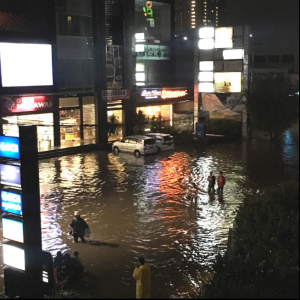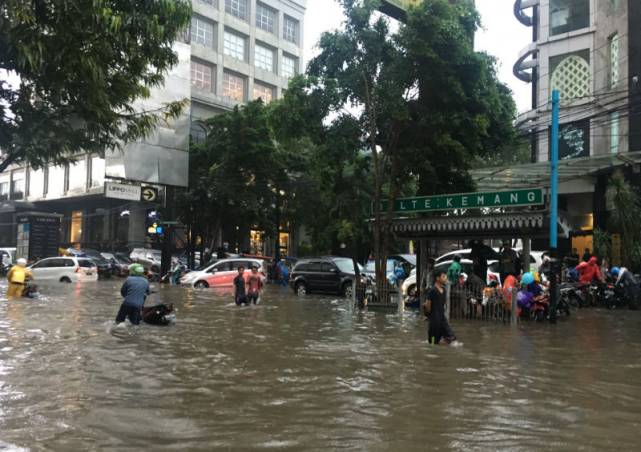After three major floods hit Kemang within a 30-day timeframe, Governor Ahok has decided to make drastic measures. With more devastating floods expected to hit the district and destroy property, the administration wants to demolish Kemang – 500 buildings to be exact –and overhaul the area’s drainage system.
Kemang wasn’t always the upscale neighbourhood that it is today. It wasn’t until after the end of the 1970s when the kampung was gentrified, and transformed into a trendy residential area for expats and affluent folks.
Kemang, which derives its name from Mangifera Kemanga, a mango species, was originally a quiet Betawi village gracefully dotted with traditional Javanese-style mosques. During the 1970s, its lush greenery and laid-back environment served as the district’s major selling point for attracting newcomers, particularly expatriates, to take up residence in the area.
Today, you will find beautiful homes tucked down narrow streets and grand residences lining the alleys in various pockets of Kemang neighbourhoods. There’s Kemang Club Villas, the gated expat community with large apartments and spacious condominiums, situated right behind the Hero complex, providing a modern mix of privacy and amenities. Attached to the Lippo Mall Kemang, Kemang Village is one of the most recent apartment developments in the region. Other fancy apartment buildings that have popped up in the neighbourhood include The Mansion and the Nirvana Residence.
Over the years, Kemang has earned repute for being a centre of high-end lifestyle for its world-class line-up of great hotels, fine-dining restaurants, and fancy cafes that continue to win the hearts of foreigners. The neighbourhood has developed into a bustling area popular for shopping, recreation, and entertainment. Tourists and locals alike seem to have a soft spot for Kemang.
According to the 1985-2005 City Master Plan, former Governor of Jakarta Sutiyoso transformed the area of Kemang from a residential neighbourhood into a commercial area in 1998. The following year, the then-governor strengthened that decision when he passed a decree declaring Kemang as a “modern kampung”.
However, a lack of robust urban planning to go with the commercialization decree resulted in the area’s ever-growing congestion problem. Worse, Kemang’s location between the Krukut River and Mampang River with no flood control system to speak of has caused a colossal flooding predicament that the residents have to endure every rainy season. And it’s getting worse.
South Jakarta is set as a water catchment area until 2030, based on the Jakarta Spatial and Areal Plan. In Kemang, however, land conversion happens fast, resulting in the loss and eradication of most water catchment areas.
South Jakarta Spatial Planning Agency Head Syukria explained that the comprehensive spatial planning of Kemang was changed in 2014 from its original function of a normal residential zone into a mixed commercial zone. This was specified in the Bylaw No. 1/2014, detailing the zoning arrangement technique on the structural planning and zoning regulations of the region.
While the Mampang district’s spatial planning map shows Kemang’s commercial area only around Jalan Kemang Raya and other spots along Jalan Kemang I and Jalan Kemang Selatan, this it not actually the case in real life. The areal commercial area now spans Jalan Bangka Raya, Jalan Kemang Selatan, and more roads even beyond the main corridor.
The zoning arrangement came with a requirement that landowners should allocate space for parking, water absorption and a three-meter sidewalk. In addition, the person proposing the function change would be required to allow land to be taken over by the government if it forms part of the road and waterway construction scheme.
Commercial development has gone uncontrolled even up to the sides of the Krukut River, which now overflows even after normal rainfall in Kemang. The riverbank is lined not only with illegal houses, but also apartments, luxury homes and hotels. Cafes, restaurants, shops and hotels occupy some roads with almost no pavement. Most of the stores, shops, and cafes have their facades closed off with asphalt and concrete that often extend to the edge of the road – sparing no land for water catchment.
Teguh Hendrawan, Head of the Jakarta Water Management Department, disclosed how commercial developments in Kemang have significantly affected the Krukut River. Sadly, what was once a 25-metre wide river has shrunk into a three-metre waterway. This is preventing a significant amount of rainwater from being diverted properly.
An urban planning analyst from the University of Trisakti, Nirwono Joga recently told the media about urgent actions Jakarta Governor Basuki “Ahok” Tjahaja Purnama should take to prevent the floods in Kemang. Joga advised building an artificial lake, upgrading to a better drainpipe system and prohibiting the construction of more homes along the Krukut riverbank.
On August 29, following the successive flooding episodes in the area, Ahok declared that there is no option other than to level a bunch of buildings. “It is the only way to prevent the floods from inundating Kemang, South Jakarta,” he said.
The governor ordered all of the buildings encroaching on the Krukut River to be fully torn down.
From a bureaucratic standpoint, Ahok acknowledged that the demolition project will be a difficult task, especially with the 2017 elections just around the corner. While an audit revealed many of the establishments did not have the proper building permits, others have permits that the governor suspects were obtained illegally. For those lands with the proper permits, however, the governor claimed that the administration will have to buy them to ensure the complete normalization of the Krukut River.
Jakarta Legislative Council Deputy Chairman Triwisaksana from the Prosperous Justice Party has expressed his support for the administration’s plan to normalize the Krukut River, encouraging the governance to be firm in the strict implementation of the rules related to spatial planning.
Similarly, Jakarta’s Vice Governor Djarot Saiful Hidayat commented on how the Krukut and Grogol rivers must be immediately normalized, as they are full of mud. He suggested the immediate evaluation of all permits for establishments on the riverbanks, following the collapse of a building on August 27, which could not withstand the water current from the Krukut River.




